Oh, so you thought a trip to Cape Point meant cute penguins and selfies while wandering willy-nilly through the fynbos? Beware. As modest as the Cape of Good Hope Nature Reserve appears, it is home to animals the size of a rhino, others with fangs longer than those of a lion. Just beyond the confines of the Cape Point car park lie creatures than can break a leopard’s jaw with a single kick. And don’t forget that those that can – and occasionally do – kill people. By stomping them to death with great clawed feet.
Lock and load: Let’s meet the Cape Point Big Five.
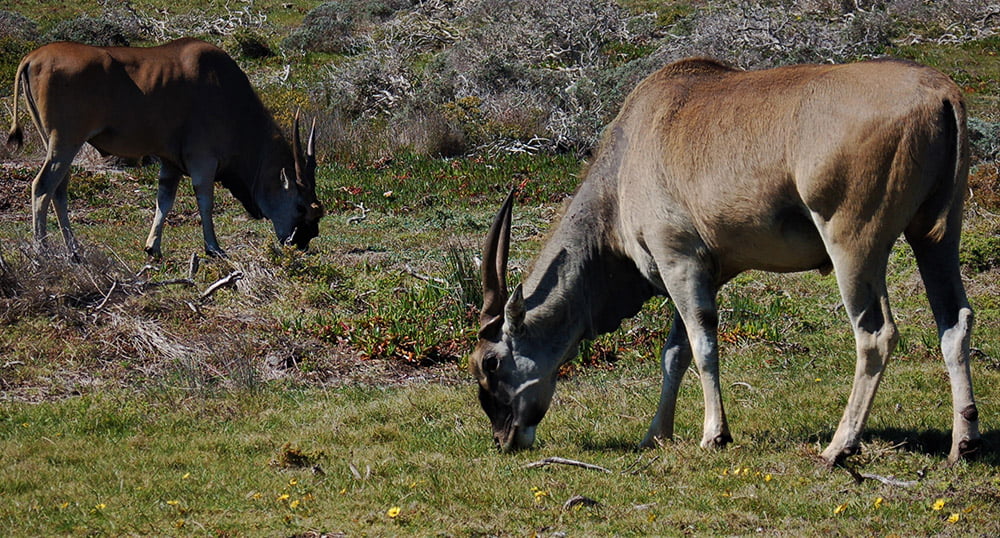
The Eland – King of Beasts
It’s hard to underestimate the role of the Eland (Taurotragus oryx) in the pre-settler Cape landscape. The 75 km² (30 mi²) Cape of Good Hope Reserve supports a herd of around seventy of them, so my guess is that huge wild-roaming herds would have once covered the Cape Peninsula, moving in for seasonal vegetation, churning up the sand, fertilizing it, clearing pathways through dense bush. In what is now Somerset West, a 40-minute drive from Cape Town, European hunters in the 1600s found mixed herds of thousands of antelope – including eland – and there’s a patch of greenery within sight of the Cape Point lighthouse known as Der Elanden Weyden – the Eland’s Grazing Grounds. These animals were everywhere.
And a good thing too. Weighing up to 900 kilogrammes (over 2000 pounds) it is the size of a female Black Rhino and was central to the indigenous Khoisan economy. Their image accounts for 90% of all animals depicted in South African prehistoric rock art, hardly surprising when an eland yielded a ton – nearly literally – of meat, a large leather hide, bones for tools and musical instruments plus a fine pair of horns.
Seemingly a cross between an ox and a deer, the first Dutch settlers were so surprised by the eland that they named it after the European Elk with a scientific name that translates as ‘bull-goat-pickaxe’. I told you they were surprised.
For such a big animal, the eland is not always easy to find in the reserve. It is generally shy but its size also ties it to areas of good grazing: look for them on the approach to the Cape of Good Hope car park, in the grassy dunes of Buffels Bay, and on the grazing lawns at Cape Point.
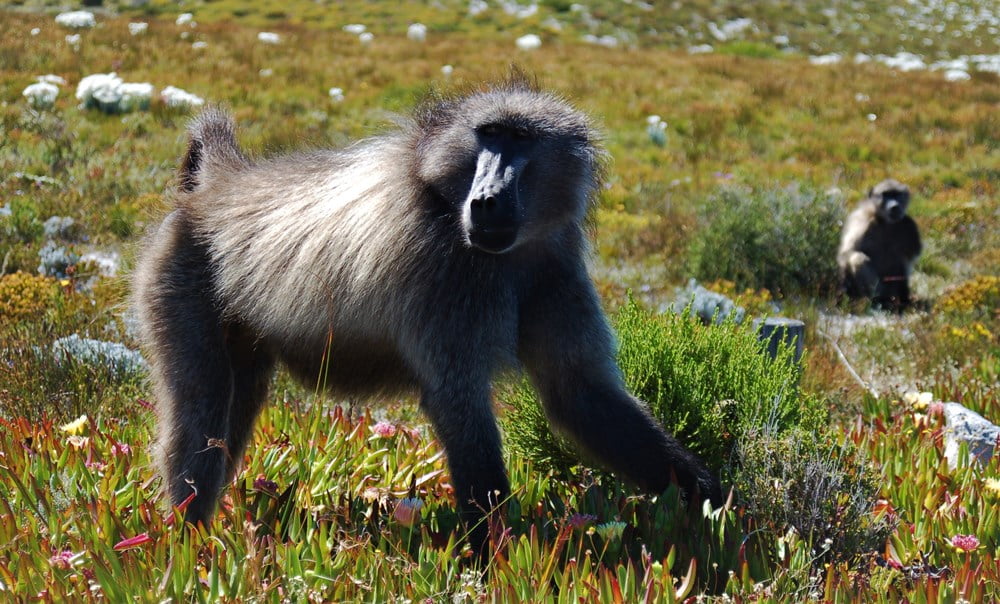
The Baboon – Joker in the Pack
“Awwww, they’re sooo cute … wait, hang on, what’s it doing? Woah! Hey hey!!” And that was the end of your picnic.
There’s no other animal that divides the people of Cape Town as much as the Chacma Baboon (Papio ursinus). It’s all about food, and when they become habituated to humans and our highly calorific offerings then baboons become a serious problem. They fearlessly enter unlocked building and cars to search for food, and snatch bags out of peoples’ hands to check inside for anything edible. Don’t bother fighting back: a big male Chacma Baboon can weigh 45 kilogrammes (100 pounds) and is armed with canine teeth longer than the ones you’ll find in the jaw of a lion, should you ever be close enough to check.
There are several baboon troops in the Cape of Good Hope Reserve and the rule of thumb is that the greater their association with a car park/picnic site, the greater their villainy. But it’s a pity baboons have earned such infamy. This is the world’s most southerly primate other than our own species and although they subsist largely on plants – roots, bulbs, flowers, seeds – it’s not unusual to see Cape Point baboons foraging for shellfish in inter-tidal rock pools. In fact, when denied the possibility of a smash-and-grab sandwich, the Cape Point baboons generally ignore you and provide great scenes as they move through the reserve’s coastal belt.
The baboons at Cape Point and Buffels Bay are regular and usually bothersome visitors to the car parks there but if you’d like to see the most natural troop on the Cape Peninsula, then head for the Olifantsbos area of the reserve. Read more about the Cape Point Baboons here.

Cape Mountain Zebra – a Rare Set of Stripes
Whether it was the Cape Mountain Zebra (Equus zebra zebra) or the half-striped Quagga (Equus quagga quagga) that astonished the newly-arrived Europeans on the Cape Peninsula, it doesn’t really matter. Whatever they were, the striped horses were shot without mercy, sending the Quagga into extinction and the Mountain Zebra to the edge of it: by the late 1960s no more than 140 individuals were left alive. The total population today does not exceed one thousand and the Cape of Good Hope is home to only a small family of them.
Incidentally, our names for the Quagga and Zebra could have come from the local Khoisan words for them: ‘Haqua’ and ‘Douqua’.
Somewhat shorter-legged and stockier than the savannah-based zebras you may have seen before, the mountain zebra was hunted by the indigenous Khoisan with spears and its meat traded with settlers. The Europeans, however, were desperate for live specimens to export (a live zebra fetched £100 in the early 1900s) and commissioned local hunters to catch them. Things did not always go according to plan: one account relates how a Khoisan man, Oedasoa, managed to get bitten by a lion while hunting elephants and trying to catch zebras.
Armed with a ferocious anti-predator kick, mountain zebras are not territorial and wander around the reserve but they are graminivores – restricted to a grass diet – which restricts them to certain areas of lower, grassy vegetation. Look for them in the top section of the reserve and on the road to Olifantsbos.
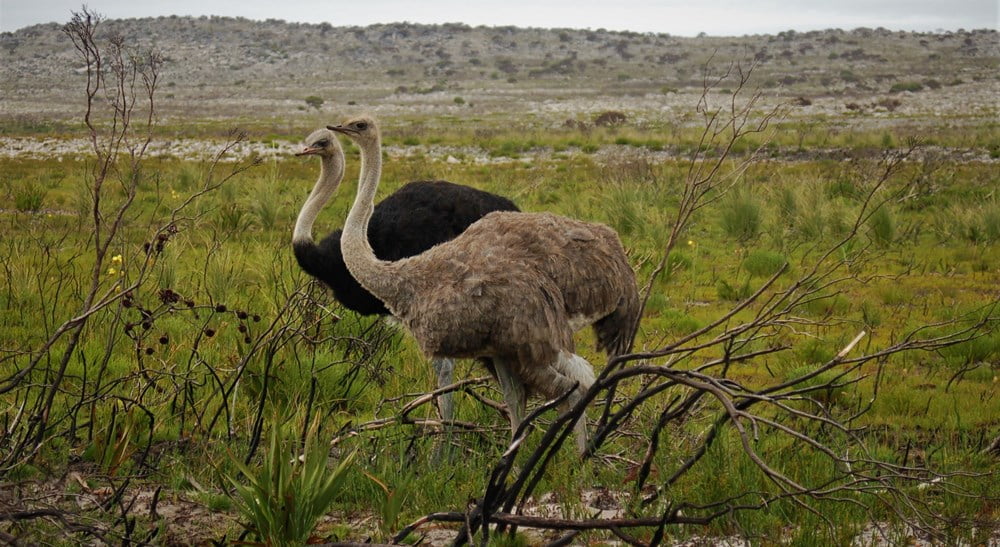
The Ostrich – Dinosaurs Live!
I grew up a dinosaur fanatic but the evolutionary segue between the extinct reptiles and today’s birds had not then been firmly established. But if you still find it hard to make the connection between the two, then the view of a South African Ostrich (Struthio camelus australis) will convince you otherwise. Walking purposefully through the fynbos, an ostrich stands up to 2.7 metres (nine feet) tall and can weigh the same as the biggest player on a rugby or American football field. Its muscular legs end in two toes, one of which bears a hooked claw which they use for defence – and attack.
Don’t think you can just run away from this feathered velociraptor. The ostrich is the world’s fastest thing on two legs, barely breaking a sweat at 50 kilometres an hour (30 miles an hour) and capable of sprinting at up to 80 km/h (50 mph) if it needs too. I’ve seen them killing chickens – the stomp technique – and every now and then a story surfaces in the South African press about an unlucky worker or visitor who gets on the wrong side of the fence at an ostrich farm.
Don’t worry about the Cape Point ostriches: given all the wild land they need, they are extremely relaxed and accommodating, often arranging themselves helpfully with an ocean backdrop for the incongruous image of ostriches by the sea. Look for them at Olifantsbos, on the coast at Buffels Bay and on the road to the Cape of Good Hope.
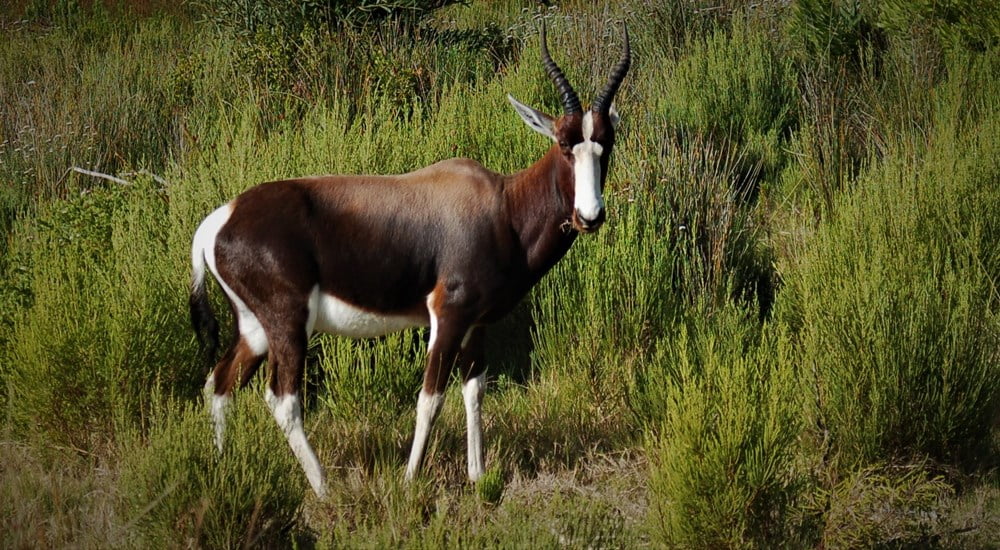
The Bontebok – the Survivor
If you were shocked by the number of Cape Mountain Zebras that remained after the Europeans had hunted them almost to oblivion, then you’d better prepare yourself for this number. Once occurring in herds thousands strong, the Bontebok (Damaliscus pygargus pygargus) was reduced to just 17 survivors before the guns fell silent. Now the rarest antelope in Southern Africa (the population is no more than 3000) the Bontebok is nevertheless one of the most handsome – the name translates as ‘multi-coloured goat’ (again, the goat thing).
To be truthful, there is no historical record of the bontebok in the Cape Town area. This graminivore was found east of the Cape Peninsula and its surrounding mountains, in what was then grassy renosterveld and is now wheat fields and apple orchards. Once extending its range all the way into the Eastern Cape, the bontebok is now restricted to a handful of reserves which often support vegetation that is critically endangered itself – a poignant partnership.
Ironically for such a rare animal, the bontebok is perhaps the easiest animal of the Cape Point Big Five to find: small herds can be seen on the grassy coastal strip at Olifantsbos and often on the beaches themselves where they apparently nibble on marine detritus for salts and minerals, elements generally lacking in a fynbos environment. Look for them also on the grass lawns at Buffels Bay and Bordjiesrif.
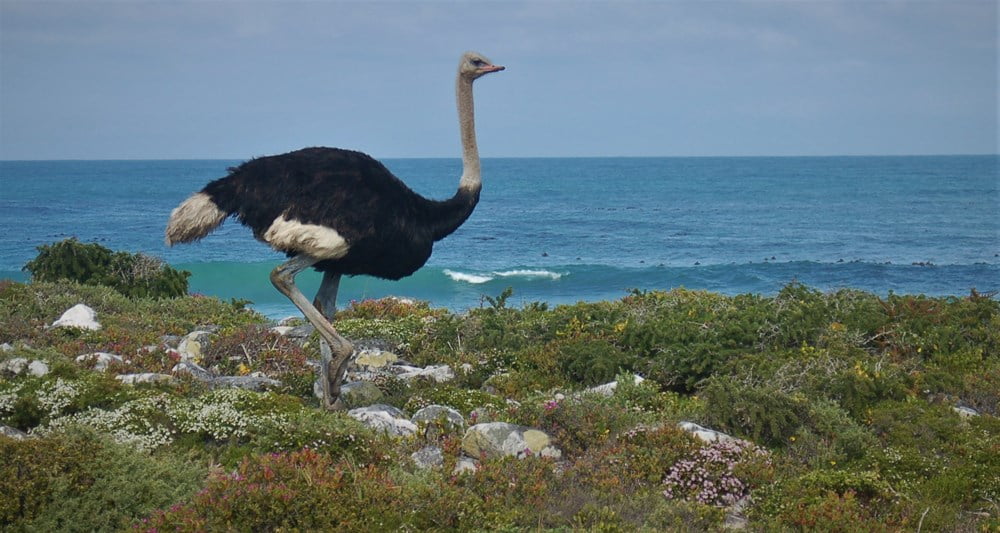
Great article – fascinating to read about other wildlife rather than the usual suspects. And, as always, written in a easy-to-access manner, while at the same time delivering loads of varied information
Love the way you interweave the historical with the zoological. Great article